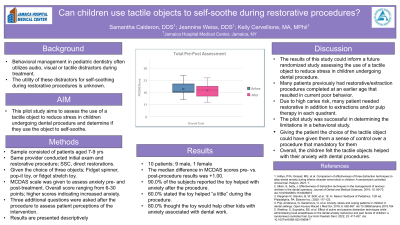Patient Management
524 - Can Children Use Tactile Objects to Self-soothe During Restorative Procedures?

- SC
Samantha Calderon, DDS (she/her/hers)
Pediatric Dental Resident
Jamaica Hospital Medical Center
Jamaica Hospital Medical Center
Oceanside, New York, United States - JW
Jeannine G. Weiss, DDS FADSA FAAHD ABPD NDBA ABSCD
Faculty
Jamaica Hospital Medical Center
Jamaica, New York, United States
Presenting Author(s)
Program Director(s)
Purpose: Behavioral management in pediatric dentistry often utilizes audio, visual or tactile distractors during treatment. The utility of these distractors for self-soothing in this context is unknown. This pilot study assessed the feasibility of incorporating tactile objects to address dental fear and anxiety in a pediatric sample.
Methods: Patients aged 7-9 seen in a community clinic for 2-3 quadrants of restorative dental treatment were included. Prior to the procedure, each patient was given the choice of three objects; a fidget spinner, pop-it toy, or fidget stretch toy. The MCDAS scale was administered to assess anxiety pre- and post-treatment, overall score ranging from 6-30 with higher scores indicating increased anxiety. Three additional questions were asked following the intervention to assess patient perceptions of the intervention. Results are presented descriptively.
Results: Ten patients were included; 9 males. Five subjects chose the pop-it toy, and four subjects chose the fidget stretch toy. The median difference in MCDAS scores pre- vs. post-procedure results was +1.00 (IQR = 1.50). 90.0% of the subjects reported the toy helped with anxiety before the procedure, 60.0% stated the toy helped “a little” during the procedure, and 80.0% thought the toy would help other kids with anxiety associated with dental work.
Conclusion: While clinically meaningful differences in MCDAS scores were not observed, patients’ self-report indicated tactile objects were helpful in managing their dental anxiety. Future research in an adequately powered sample is warranted and should incorporate patients with documented histories of dental anxiety.
Identify Supporting Agency and Grant Number:

.jpg)